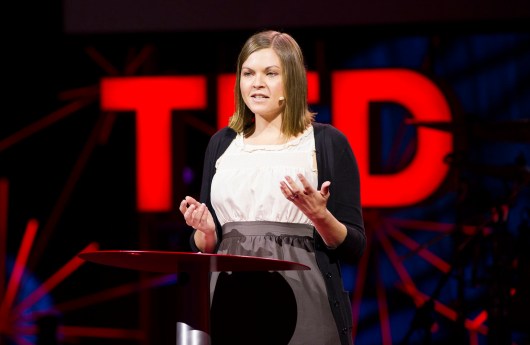A story of fear
In 1819, off the coast of Chile, 20 American sailors watch their whaleship, the Essex, fill with seawater. It had been struck by a sperm whale. They took to their small boats, with limited equipment and little food and water. This story, from Stove by a Whale, the narrative of Owen Chase, is the story that would inspire Moby-Dick, and the story that Karen Thompson Walker uses to start her talk on fear.
“We all know fear,” says Walker, “but we think of fear as a weakness.” We’re wired, she says, to be optimists. We conquer fear, fight it, “but what if we thought of fear as an amazing act of the imagination.”
This view is easiest to see in young children, with vivid fears. When she was a child in California, she was scared watching the chandelier swing in every tiny earthquake. What we say about these kids is that they “have a vivid imagination.” But these are the same impulses that produced the works of Darwin, the Brontës and Proust.
A story of three fears
Returning to the Essex, what fears did the have? They had few options. They had heard that the nearest islands were populated by cannibals. They could go to Hawaii, but worried they’d be struck by storms. The last option was to go 1,500 miles due south to catch a band of winds and reach the coast of South America.
So: be eaten by canibals, starve to death, or drown. For days they deliberated over these three options, three fears.
But, asks Walker, “what if we called these stories instead of fears?” Fear is unintentional storytelling. They have characters, plots, imagery. They’re as visible as anything you’ll find anywhere else. Fears produce the same sense of suspense as great stories. The question is, “What will happen next? In other words, our fears make us think about the future.”
Humans are the only animals who can project ourselves into the future. In those projections we write a story, whether we’re daydreaming or fearing that future. “We should think of ourselves as the authors of those stories, and more importantly the readers of our fears.” Successful entrepreneurs, she has heard, read their fears closely and study them for productive answers.
Fear of our own stories
But we can’t prepare for all the fears we concoct. So how do we prepare?
After deliberation, the sailors of the Essex decided to go to South America. Fearing the cannibals more than anything, they went south, ran out of food, and became cannibals themselves. Why, asks Walker, did they fear cannibals so much more than starvation?
Quoting Nabokov, she says that the best reader has two sides, the artistic and the scientific. The second tends to temper the first. The problem with the sailors was that “they responded only to the most lurid, the most vivid.” But maybe if they were able to read their fears like a scientist, they might have been able to listen to the most likely fear — rather than the most frightening.
We should do the same: Become less afraid of plane crashes, and more afraid of the buildup of plaque in arteries, or the gradual change in climate.
“When read in the right way, our fears are an incredible gift of the imagination. Properly read, our fears are as precious as our favorite literature,” and they can give us “a little wisdom, some insight, and a vision of that most elusive thing, the truth.”
Photo: James Duncan Davidson

Comments (5)
Pingback: Looking forward, looking back: TEDGlobal 2012 recap - Entrepreneur News | Australian Society of Entrepreneurs
Pingback: Fear – Motivates Our Imagination | fearphobe
Pingback: What fear can teach us | Kelly Business Advisors, LLC
Pingback: Memories and Fears | JoggerJess.com
Pingback: Karen Walker Thompson: Be Very Afraid | Park Slope Stoop